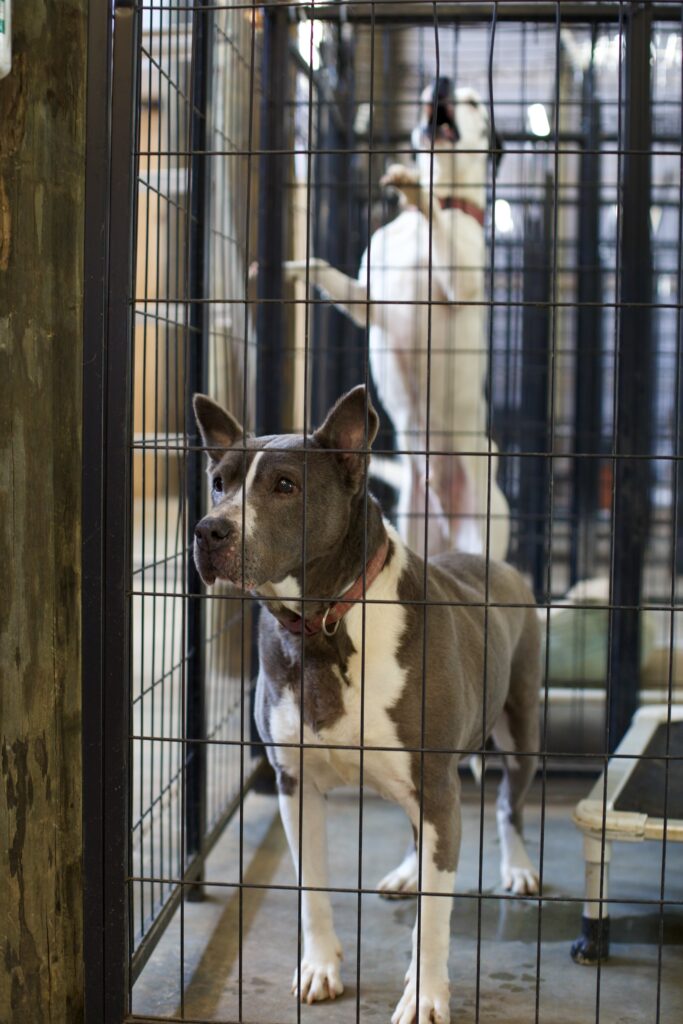In the back corner of Dirt Road Doggies Rescue, a Staffordshire Bull Terrier named Tink-Tink wags her tail behind chain-link fencing, waiting for her chance at a forever home. Without a foster or adopter, she is becoming another statistic — one of thousands of dogs in Northeast Georgia caught in the growing crisis: overcrowded shelters and dwindling fosters.

Couple Starts Business
Mike and Gabi Osterberger never imagined the scope of the problem when they started Dirt Road Doggies Rescue in 2015. With nearly 3.2 million dogs entering shelters in 2023 and 360,000 being euthanized, the Osterbergers’ small, foster-based nonprofit in Northeast Georgia has become a lifeline for dogs with nowhere else to go.
“We thought helping dogs on the road would keep us busy,” said Gabi. “Once we got into it, we really understood how big the problem was — and we felt like we needed to help however we could.”
In the last decade, the Osterbergers and a dedicated network of volunteers have rescued nearly 1,500 dogs. They take in strays, last-chance shelter dogs and emergency cases — even when fosters are hard to come by.
“We’re not breed specific. We’ll take any breed and if there are medical cases, we’ll take those too,” Gabi said. “It’s heartbreaking and overwhelming, I don’t know what the answer is, but I feel like it’s worse than when we started.”
In March, the rescue pulled Beatrice, a dog with a broken leg, from Jackson County Animal Control — just days before she was scheduled to be euthanized.
“The foster family that took her already had a foster puppy but she saw her story and couldn’t leave her,” Gabi said.

Foster families are the backbone of Dirt Road Doggies Rescue. But since the pandemic, the number of available fosters has dropped dramatically.
“People want to get out and travel; they don’t want to be tied down,” said Gabi. “We struggle to get new fosters and keep them.”
Why It’s Newsworthy: Overcrowding continues to burden local animal shelters and rescues as foster rates decline following the pandemic.Foster Saves Dogs From Euthanasia
Lauren Norwood has been fostering for Dirt Road Doggies since 2015. Over the years, she’s taken in more than 10 dogs and adopted three.

“There are so many animals out there that just need to find the right home, and I can’t help all of them but the ones I can help, I can feel good about making a difference,” Norwood said.
Government Shelters Find Solutions
Local rescues aren’t alone in their efforts to find homes for these animals. Government shelters, like Athens-Clarke County Animal Services, have turned to transport programs as a solution.
“Transport is just another way for us to think outside the box and get animals out to a good home. If we did not have transport, we would not be able to adopt them all, we would have to do more humane euthanasia,” said Kristall Barber, director of Animal Services for the Athens-Clarke County Unified Government.
Last year alone, Athens-Clarke County Animal Services shipped over 1,400 dogs to northern rescue groups.

Of all animals in the shelter, large breed dogs are overlooked time and time again, making them more likely to be thrown onto transport vehicles or worse, euthanized.
“There are times where we have to euthanize because they just have deteriorated, they’re either not safe to be here anymore or they’re just not doing well, and it’s not in their best interest to just be in a cage,” said Barber. “That’s the simple fact of it, there is not anybody that’s adopting these large dogs.”
Barber emphasized the importance of fostering to help overcrowding conditions, not only to keep dogs out of the shelter, but to positively impact the dogs’ mental health.
“The social and comfort aspect that a home can provide for an animal is just, it’s indescribable as part of how much it will get them to a new home or their forever home,” she said.
As intake numbers rise, both rescues and shelters are in urgent need of fosters. Adoption is always the goal — but fostering offers dogs like Beatrice and Tink-Tink a second chance before it’s too late.
Jessica Savage is a fourth-year student majoring in journalism.









Show Comments (0)